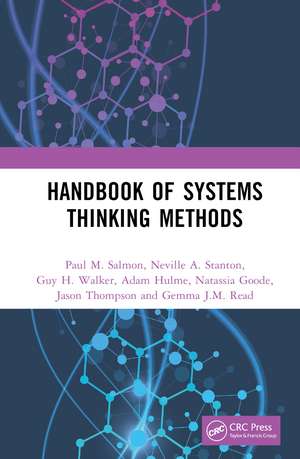Handbook of Systems Thinking Methods
Autor Paul M. Salmon, Neville a. Stanton, Guy H. Walker, Adam Hulme, Natassia Goode, Jason Thompson, Gemma J.M. Readen Limba Engleză Hardback – 19 aug 2022
The book presents practical guidance on state-of-the-art systems thinking methods and offers case study applications describing systems thinking methods in novel areas. It explains how to translate the outputs of systems thinking methods in practice and introduces systems thinking with an overview of Human Factors and Ergonomics applications.
This book will serve as a great reference for students and engineers in the field of systems engineering, complex systems and the design and development of systems, including ergonomics/human factors and systems engineers, designers, architects, industrial engineers, project management engineers, reliability engineers, risk engineers, software engineers and computer engineers.
Preț: 897.04 lei
Preț vechi: 1093.94 lei
-18% Nou
Puncte Express: 1346
Preț estimativ în valută:
171.65€ • 177.08$ • 143.24£
171.65€ • 177.08$ • 143.24£
Carte tipărită la comandă
Livrare economică 27 martie-10 aprilie
Preluare comenzi: 021 569.72.76
Specificații
ISBN-13: 9780367220174
ISBN-10: 0367220172
Pagini: 330
Ilustrații: 34 Tables, black and white; 95 Line drawings, black and white; 3 Halftones, black and white; 98 Illustrations, black and white
Dimensiuni: 156 x 234 x 19 mm
Greutate: 0.62 kg
Ediția:1
Editura: CRC Press
Colecția CRC Press
Locul publicării:Boca Raton, United States
ISBN-10: 0367220172
Pagini: 330
Ilustrații: 34 Tables, black and white; 95 Line drawings, black and white; 3 Halftones, black and white; 98 Illustrations, black and white
Dimensiuni: 156 x 234 x 19 mm
Greutate: 0.62 kg
Ediția:1
Editura: CRC Press
Colecția CRC Press
Locul publicării:Boca Raton, United States
Public țintă
Academic and ProfessionalCuprins
SECTION I Introduction to Systems Thinking
1. Introduction to Systems Thinking in Human Factors and Ergonomics and Safety Science.
SECTION II Risk Assessment Methods
2. The Networked Hazard Analysis and Risk Management System (Net-HARMS).
3. The Event Analysis of the Systemic Teamwork Broken Links (EAST-BL).
4 The Systems Theoretic Process Analysis (STPA) Method.
SECTION III Systems Analysis and Design Methods
5. Hierarchical Task Analysis (HTA).
6. Cognitive Work Analysis (CWA).
7. The Event Analysis of Systemic Teamwork (EAST).
8. Causal Loop Diagrams (CLDs).
SECTION IV Accident Analysis Methods
9. The Accident Mapping (AcciMap) Method.
10. The Accident Network (AcciNet).
11. The Systems Theoretic Accident Model and Process-Causal Analysis based on Systems Theory (STAMP-CAST) Method.
SECTION V Computational Modelling Methods
12. Agent Based Modelling (ABM).
13. System Dynamics.
SECTION VI Many Model Systems Thinking
14. A Many-Model Systems Thinking Approach.
1. Introduction to Systems Thinking in Human Factors and Ergonomics and Safety Science.
SECTION II Risk Assessment Methods
2. The Networked Hazard Analysis and Risk Management System (Net-HARMS).
3. The Event Analysis of the Systemic Teamwork Broken Links (EAST-BL).
4 The Systems Theoretic Process Analysis (STPA) Method.
SECTION III Systems Analysis and Design Methods
5. Hierarchical Task Analysis (HTA).
6. Cognitive Work Analysis (CWA).
7. The Event Analysis of Systemic Teamwork (EAST).
8. Causal Loop Diagrams (CLDs).
SECTION IV Accident Analysis Methods
9. The Accident Mapping (AcciMap) Method.
10. The Accident Network (AcciNet).
11. The Systems Theoretic Accident Model and Process-Causal Analysis based on Systems Theory (STAMP-CAST) Method.
SECTION V Computational Modelling Methods
12. Agent Based Modelling (ABM).
13. System Dynamics.
SECTION VI Many Model Systems Thinking
14. A Many-Model Systems Thinking Approach.
Notă biografică
Paul M. Salmon is a Professor in Human Factors and is the Director of the Centre for Human Factors and Sociotechnical Systems at the University of the Sunshine Coast.
Neville A. Stanton is a Chartered Psychologist, Chartered Ergonomist and Chartered Engineer. He holds the Chair in Human Factors Engineering in the Faculty of Engineering and the Environment at the University of Southampton in the UK.
Guy H. Walker is a Professor within the Centre for Sustainable Road Freight at Heriot-Watt University in Edinburgh.
Adam Hulme is a Research Fellow at the Centre for Human Factors and Sociotechnical Systems at the University of the Sunshine Coast.
Natassia Goode is a Program Manager at WorkSafe Victoria, and Adjunct Fellow within the Centre for Human Factors and Sociotechnical Systems at the University of the Sunshine Coast.
Jason Thompson is an Associate Professor the University of Melbourne’s School of Medicine and Melbourne School of Design.".
Gemma J. M. Read is a Senior Research Fellow at the Centre for Human Factors and Sociotechnical Systems at the University of the Sunshine Coast.
Neville A. Stanton is a Chartered Psychologist, Chartered Ergonomist and Chartered Engineer. He holds the Chair in Human Factors Engineering in the Faculty of Engineering and the Environment at the University of Southampton in the UK.
Guy H. Walker is a Professor within the Centre for Sustainable Road Freight at Heriot-Watt University in Edinburgh.
Adam Hulme is a Research Fellow at the Centre for Human Factors and Sociotechnical Systems at the University of the Sunshine Coast.
Natassia Goode is a Program Manager at WorkSafe Victoria, and Adjunct Fellow within the Centre for Human Factors and Sociotechnical Systems at the University of the Sunshine Coast.
Jason Thompson is an Associate Professor the University of Melbourne’s School of Medicine and Melbourne School of Design.".
Gemma J. M. Read is a Senior Research Fellow at the Centre for Human Factors and Sociotechnical Systems at the University of the Sunshine Coast.
Descriere
This handbook presents practical step-by-step guidance for practitioners and researchers wishing to use these methods to tackle complex problems. Each method includes an example case study which demonstrates how the method can be applied and how the results can be interpreted and translated into practical recommendations.
